8 books about Bordo, Michael D.
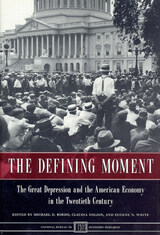
The Defining Moment
The Great Depression and the American Economy in the Twentieth Century
Edited by Michael D. Bordo, Claudia Goldin, and Eugene N. White
University of Chicago Press, 1997
In contemporary American political discourse, issues related to the scope, authority, and the cost of the federal government are perennially at the center of discussion. Any historical analysis of this topic points directly to the Great Depression, the "moment" to which most historians and economists connect the origins of the fiscal, monetary, and social policies that have characterized American government in the second half of the twentieth century. In the most comprehensive collection of essays available on these topics, The Defining Moment poses the question directly: to what extent, if any, was the Depression a watershed period in the history of the American economy? This volume organizes twelve scholars' responses into four categories: fiscal and monetary policies, the economic expansion of government, the innovation and extension of social programs, and the changing international economy. The central focus across the chapters is the well-known alternations to national government during the 1930s. The Defining Moment attempts to evaluate the significance of the past half-century to the American economy, while not omitting reference to the 1930s.
The essays consider whether New Deal-style legislation continues to operate today as originally envisioned, whether it altered government and the economy as substantially as did policies inaugurated during World War II, the 1950s, and the 1960s, and whether the legislation had important precedents before the Depression, specifically during World War I. Some chapters find that, surprisingly, in certain areas such as labor organization, the 1930s responses to the Depression contributed less to lasting change in the economy than a traditional view of the time would suggest. On the whole, however, these essays offer testimony to the Depression's legacy as a "defining moment." The large role of today's government and its methods of intervention—from the pursuit of a more active monetary policy to the maintenance and extension of a wide range of insurance for labor and business—derive from the crisis years of the 1930s.
The essays consider whether New Deal-style legislation continues to operate today as originally envisioned, whether it altered government and the economy as substantially as did policies inaugurated during World War II, the 1950s, and the 1960s, and whether the legislation had important precedents before the Depression, specifically during World War I. Some chapters find that, surprisingly, in certain areas such as labor organization, the 1930s responses to the Depression contributed less to lasting change in the economy than a traditional view of the time would suggest. On the whole, however, these essays offer testimony to the Depression's legacy as a "defining moment." The large role of today's government and its methods of intervention—from the pursuit of a more active monetary policy to the maintenance and extension of a wide range of insurance for labor and business—derive from the crisis years of the 1930s.
[more]
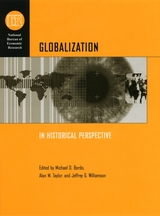
Globalization in Historical Perspective
Edited by Michael D. Bordo, Alan M. Taylor, and Jeffrey G. Williamson
University of Chicago Press, 2003
As awareness of the process of globalization grows and the study of its effects becomes increasingly important to governments and businesses (as well as to a sizable opposition), the need for historical understanding also increases. Despite the importance of the topic, few attempts have been made to present a long-term economic analysis of the phenomenon, one that frames the issue by examining its place in the long history of international integration.
This volume collects eleven papers doing exactly that and more. The first group of essays explores how the process of globalization can be measured in terms of the long-term integration of different markets-from the markets for goods and commodities to those for labor and capital, and from the sixteenth century to the present. The second set of contributions places this knowledge in a wider context, examining some of the trends and questions that have emerged as markets converge and diverge: the roles of technology and geography are both considered, along with the controversial issues of globalization's effects on inequality and social justice and the roles of political institutions in responding to them. The final group of essays addresses the international financial systems that play such a large part in guiding the process of globalization, considering the influence of exchange rate regimes, financial development, financial crises, and the architecture of the international financial system itself.
This volume reveals a much larger picture of the process of globalization, one that stretches from the establishment of a global economic system during the nineteenth century through the disruptions of two world wars and the Great Depression into the present day. The keen analysis, insight, and wisdom in this volume will have something to offer a wide range of readers interested in this important issue.
This volume collects eleven papers doing exactly that and more. The first group of essays explores how the process of globalization can be measured in terms of the long-term integration of different markets-from the markets for goods and commodities to those for labor and capital, and from the sixteenth century to the present. The second set of contributions places this knowledge in a wider context, examining some of the trends and questions that have emerged as markets converge and diverge: the roles of technology and geography are both considered, along with the controversial issues of globalization's effects on inequality and social justice and the roles of political institutions in responding to them. The final group of essays addresses the international financial systems that play such a large part in guiding the process of globalization, considering the influence of exchange rate regimes, financial development, financial crises, and the architecture of the international financial system itself.
This volume reveals a much larger picture of the process of globalization, one that stretches from the establishment of a global economic system during the nineteenth century through the disruptions of two world wars and the Great Depression into the present day. The keen analysis, insight, and wisdom in this volume will have something to offer a wide range of readers interested in this important issue.
[more]
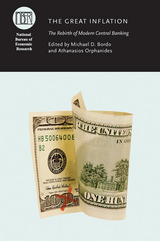
The Great Inflation
The Rebirth of Modern Central Banking
Edited by Michael D. Bordo and Athanasios Orphanides
University of Chicago Press, 2013
Controlling inflation is among the most important objectives of economic policy. By maintaining price stability, policy makers are able to reduce uncertainty, improve price-monitoring mechanisms, and facilitate more efficient planning and allocation of resources, thereby raising productivity.
This volume focuses on understanding the causes of the Great Inflation of the 1970s and ’80s, which saw rising inflation in many nations, and which propelled interest rates across the developing world into the double digits. In the decades since, the immediate cause of the period’s rise in inflation has been the subject of considerable debate. Among the areas of contention are the role of monetary policy in driving inflation and the implications this had both for policy design and for evaluating the performance of those who set the policy. Here, contributors map monetary policy from the 1960s to the present, shedding light on the ways in which the lessons of the Great Inflation were absorbed and applied to today’s global and increasingly complex economic environment.
[more]
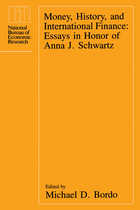
Money, History, and International Finance
Essays in Honor of Anna J. Schwartz
Edited by Michael D. Bordo
University of Chicago Press, 1989
This volume provides a critical evaluation of Anna J. Schwartz's work and probes various facets of the immense contribution of her scholarship—How well has it stood the test of time? What critiques have been leveled against it? How has monetary research developed over the years, and how has her influence been manifested? Bordo has collected five conference papers presented by leading monetary scholars, discussants' comments, and closing remarks by Milton Friedman and Karl Brunner. Each of these insightful surveys extends Schwartz's work and makes its own contribution to the fields of monetary history, theory, and policy. The volume also contains a foreword by Martin Feldstein and a selected bibliography of publications by Anna Schwartz.
[more]
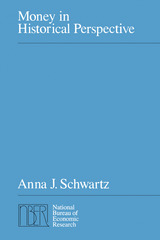
Money in Historical Perspective
Anna J. Schwartz
University of Chicago Press, 1987
Modern monetary economics has been significantly influenced by the knowledge and insight brought to the field by the work of Anna J. Schwartz, an economist whose career has spanned almost half a century. Her contributions evidence a broad expertise in international history and policy, and an ability to apply the results of her careful historical research to current issues and debates. Money in Historical Perspective is a collection of sixteen of her papers selected by Michael D. Bordo and Milton Friedman. Grouped into three sections, the essays constitute a number of Dr. Schwartz's most cited articles on the subject of monetary economics, many of which are no longer readily accessible.
In the papers in part I, dating from 1947 to the present, Dr. Schwartz examines money and banking in the United States and the United Kingdom from a historical perspective. Her investigation of the historical evidence linking economic instability to erratic monetary behavior—this behavior itself a product of discretionary monetary policy—has led her to argue for the importance of stable money, and her writings on these issues over the last two decades form part II. The volume concludes with four recent articles on international monetary arrangements, including Dr. Schwartz's well-known work on the gold standard.
This volume of classic essays by Anna Schwartz will be a useful addition to the libraries of scholars and students for its exemplary historical research and commentary on monetary systems.
In the papers in part I, dating from 1947 to the present, Dr. Schwartz examines money and banking in the United States and the United Kingdom from a historical perspective. Her investigation of the historical evidence linking economic instability to erratic monetary behavior—this behavior itself a product of discretionary monetary policy—has led her to argue for the importance of stable money, and her writings on these issues over the last two decades form part II. The volume concludes with four recent articles on international monetary arrangements, including Dr. Schwartz's well-known work on the gold standard.
This volume of classic essays by Anna Schwartz will be a useful addition to the libraries of scholars and students for its exemplary historical research and commentary on monetary systems.
[more]
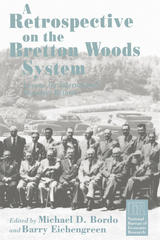
A Retrospective on the Bretton Woods System
Lessons for International Monetary Reform
Edited by Michael D. Bordo and Barry Eichengreen
University of Chicago Press, 1993
At the close of the Second World War, when industrialized nations faced serious trade and financial imbalances, delegates from forty-four countries met in Bretton Woods, New Hampshire, in order to reconstruct the international monetary system. In this volume, three generations of scholars and policy makers, some of whom participated in the 1944 conference, consider how the Bretton Woods System contributed to unprecedented economic stability and rapid growth for 25 years and discuss the problems that plagued the system and led to its eventual collapse in 1971.
The contributors explore adjustment, liquidity, and transmission under the System; the way it affected developing countries; and the role of the International Monetary Fund in maintaining a stable rate. The authors examine the reasons for the System's success and eventual collapse, compare it to subsequent monetary regimes, such as the European Monetary System, and address the possibility of a new fixed exchange rate for today's world.
The contributors explore adjustment, liquidity, and transmission under the System; the way it affected developing countries; and the role of the International Monetary Fund in maintaining a stable rate. The authors examine the reasons for the System's success and eventual collapse, compare it to subsequent monetary regimes, such as the European Monetary System, and address the possibility of a new fixed exchange rate for today's world.
[more]
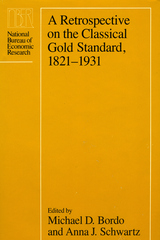
A Retrospective on the Classical Gold Standard, 1821-1931
Edited by Michael D. Bordo and Anna J. Schwartz
University of Chicago Press, 1984
This is a timely review of the gold standard covering the 110 years of its operation until 1931, when Britain abandoned it in the midst of the Depression. Current dissatisfaction with floating rates of exchange has spurred interest in a return to a commodity standard. The studies in this volume were designed to gain a better understanding of the historical gold standard, but they also throw light on the question of whether restoring it today could help cure inflation, high interest rates, and low productivity growth.
The volume includes a review of the literature on the classical gold standard; studies the experience with gold in England, Germany, Italy, Sweden, and Canada; and perspectives on international linkages and the stability of price-level trends under the gold standard. The articles and commentaries reflect strong, conflicting views among hte participants on issues of central bank behavior, purchasing-power an interest-rate parity, independent monetary policies, economic growth, the "Atlantic economy," and trends in commodity prices and long-term interest rates. This is a thoughtful and provocative book.
The volume includes a review of the literature on the classical gold standard; studies the experience with gold in England, Germany, Italy, Sweden, and Canada; and perspectives on international linkages and the stability of price-level trends under the gold standard. The articles and commentaries reflect strong, conflicting views among hte participants on issues of central bank behavior, purchasing-power an interest-rate parity, independent monetary policies, economic growth, the "Atlantic economy," and trends in commodity prices and long-term interest rates. This is a thoughtful and provocative book.
[more]
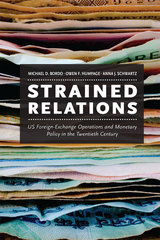
Strained Relations
US Foreign-Exchange Operations and Monetary Policy in the Twentieth Century
Michael D. Bordo, Owen F. Humpage, and Anna J. Schwartz
University of Chicago Press, 2015
During the twentieth century, foreign-exchange intervention was sometimes used in an attempt to solve the fundamental trilemma of international finance, which holds that countries cannot simultaneously pursue independent monetary policies, stabilize their exchange rates, and benefit from free cross-border financial flows. Drawing on a trove of previously confidential data, Strained Relations reveals the evolution of US policy regarding currency market intervention, and its interaction with monetary policy. The authors consider how foreign-exchange intervention was affected by changing economic and institutional circumstances—most notably the abandonment of the international gold standard—and how political and bureaucratic factors affected this aspect of public policy.
[more]
READERS
Browse our collection.
PUBLISHERS
See BiblioVault's publisher services.
STUDENT SERVICES
Files for college accessibility offices.
UChicago Accessibility Resources
home | accessibility | search | about | contact us
BiblioVault ® 2001 - 2024
The University of Chicago Press









